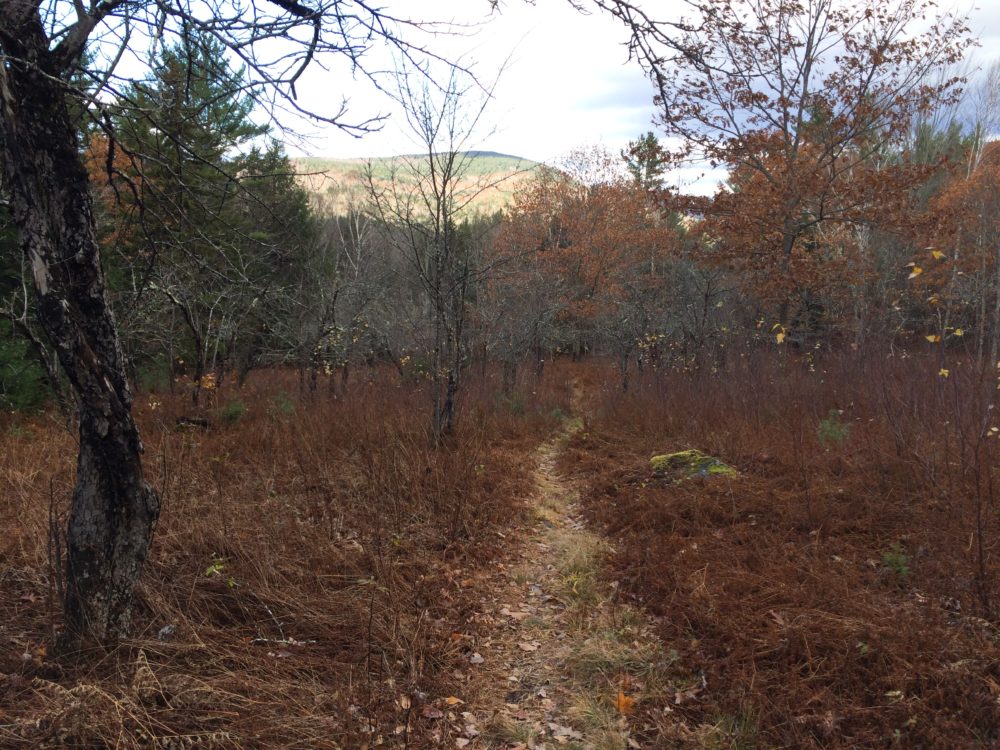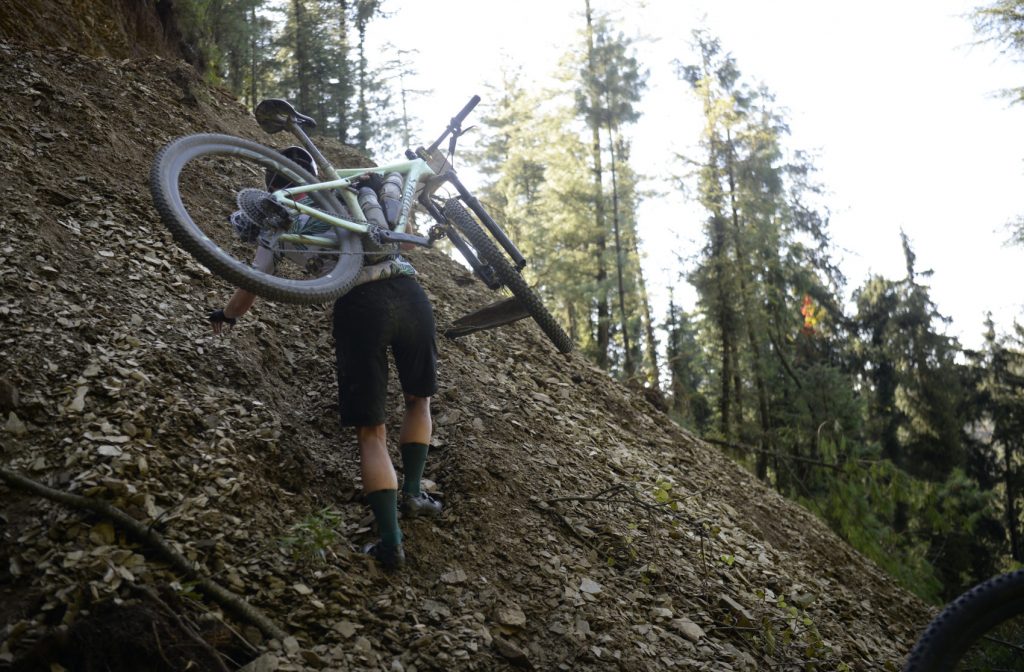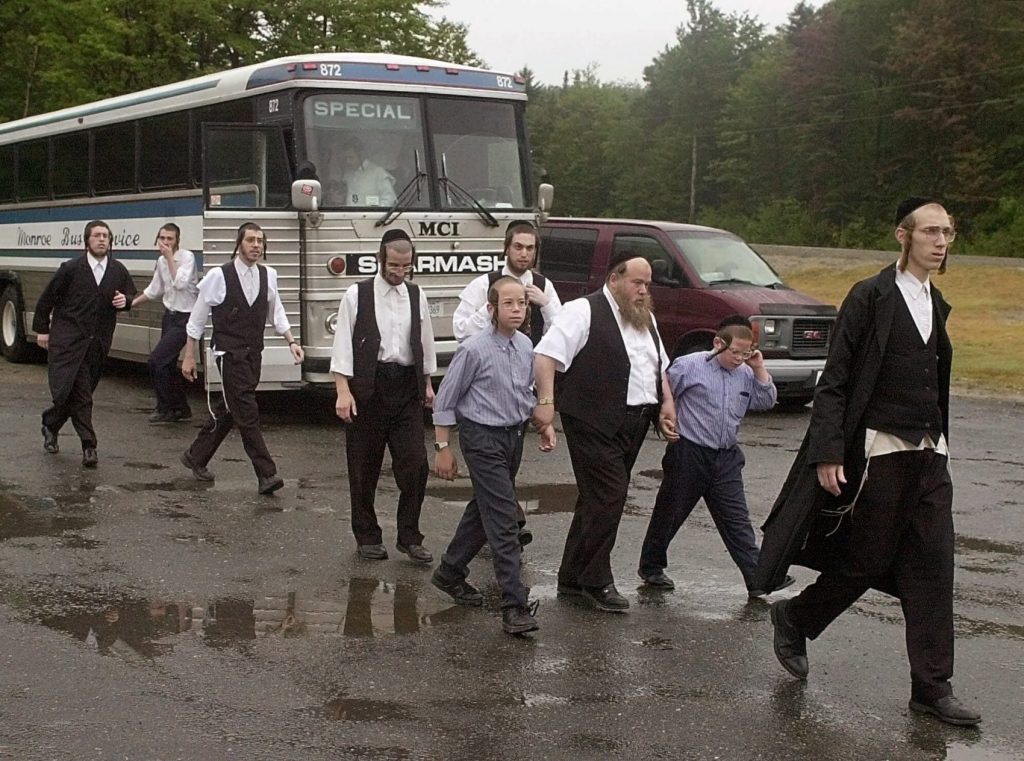Article reposted from WBUR OAG with permission – see the original post.

A mountain bike trail in Thornton, N.H. (Courtesy Sam Evans-Brown)
For years, mountain bikers have been kind of like the woodsy version of skateboarders in a city: using the landscape not built for them, carving their own paths into the hills. And that rogue culture — the fact that it was illegal and secret — was part of the allure.
But what happens when the evolution of a sport threatens the very thing that made it so attractive in the first place?
Pirate Trails
Jody Chinchen is the District Trails Manager on the Pemigewasset Ranger District. She and I are walking through the Smarts Brook trail system in the While Mountain National Forest in New Hampshire. In other words, federal property.
And we’re walking on some trails that aren’t exactly legal. And they’re pretty clearly defined.
Chinchen calls these trails incidental trails. User-created trails. Non-network trails. Bureaucratic euphemisms for what they are: trails that got built on federal land without permission. She estimates there are 35 or 40 miles of these trails just in her district of the national forest.
The Forest Service is trying to fold these pirate mountain bike trails into the official trail system. And the best people to help them do this are also the very people who built the off-the-map trails in the first place.
“Mountain bikers are obviously a biggie,” Chinchen says. “They do a lot of work. They have a lot of energy.”
It’s like how, for years, city officials used to put up signs that said, ‘No Skateboarding’ and would hassle kids who scraped up the new granite steps in front of the courthouse. But eventually, they gave up and built the kids a skate park.
Chinchen shows me a trail that has been designated for a redesign. They’ve put up markers designating a new, more erosion-friendly route — down a hill and around an apple orchard — that the wildlife likes. But as we follow the new trail, we notice the flagging has been pulled down off the trees.
Some mountain biker is trying to sabotage Chinchen’s work.
“There are some adversaries to this project,” she says. “There’s the people who want this trail to remain low use, and they want to maintain the character of the network just as it is.”
Why would mountain bikers not want people to get out and ride bikes? To understand that, we need some Mountain Biking History 101.
Mountain Biking History 101
Dave Harkless is a bike shop owner in Littleton, New Hampshire.
“I’m one of the guys in this town that make this town fun to live in,” he says.
Harkless is a connected figure in New England mountain biking. He’s kind of an ambassador for the sport — maybe a little scruffy, but he tucks his t-shirt in.
“As I’ve matured, shall we say, I try to stick to legit trails,” he says.
Gardner Kellogg is a surveyor in the same town.
“I’m 71 years old, and I’ve been doing this mountain biking for probably longer than I should have,” Kellogg jokes.
Kellogg bought one of the very first mass-produced mountain bikes back in the early ’80s, and he’s built a lot of trails in his day. And I think at the time, he saw it as a victimless crime.
“Earlier on, there just weren’t that many people riding, and it didn’t really matter that much,” he says.
Just like the early skateboarders who drained pools in uninhabited second homes in their California neighborhoods, the early mountain bikers found a place to take their new rigs.
“We’d just go into the woods and start clearing a way to get from one point to another,” Kellogg says. “By hook or by crook.”
Pirate Trail Perils
If you’ve ever been walking and turned onto a trail that suddenly is zig-zagging, maze-like, through the woods, winding crazily through the trees and doubling back on itself … that’s a mountain bike trail. Mountain bikers don’t want views or destinations — they want corners and obstacles to get over and downhills and to ride their bikes until they’re tired and wind up back where they started.
And they want it close to home. Which means, often, these trails were built in whatever woods were nearest by — no matter whose they were.
“A lot of landowners up here are absentee landowners,” Harkless says. “A lot of land is old land in old families, been handed down through generations. They don’t necessarily live on their land.”
But not asking for permission can be a recipe for conflict.
“Have you ever had the experience of a private landowner who didn’t know there was a trail on their land finding you to talk to you about it? And what are those conversations like?” I ask.
“There have been conversations,” Kellogg says. “And some are nicer than other conversations.”
A lot of these trails were built by experts who were looking for things that were fun and challenging. But that also made the trails horrendously difficult for new riders.
“And they were tight, they were twisty, they were extremely technical,” Harkless says. “You could have 24 inches between the trees. There’s still some trails like that around here, and we call them skinnies.”
Riding these lines is intense. You fall over. You crash on the downhills. You can hurt yourself.
“It can be extremely frustrating,” Harkless says. “If somebody is looking to get into riding, and this is their first experience, they’re going to have to be a very determined person to be successful. Send ‘em up there and like, ‘Go ride our trails. They’re really fun, they’re really awesome.’ They come back bloody and pissed.”
And, because these trails were built without permission, the people who built them wanted them to stay under the radar so they wouldn’t get kicked off.
So … no trail signs. Trail signs invite in outsiders. Trail signs bring attention. No trail signs.

Photo credit TAUSEEF MUSTAFA/AFP/Getty Images
Maybe you’re asking, “So what? Who cares if there are pirate trails?”
Well, let me tell you a story.
Abraham Hauer
“The Rabbi and his wife came to take a walk up the hill,” says Mark Taylor, who worked for 20 years as a police officer in Franconia, New Hampshire. “She didn’t want to go. She stayed in the car.”
Taylor may sound like he’s setting up a joke, but he’s not. He told me about a search and rescue that happened in 2001, when a Rabbi from Brooklyn named Abraham Hauer came up to the White Mountains.
“It’s a fairly well-defined trail here, and it basically forms this loop about a mile and half, all the way around,” Taylor says.
Abraham’s wife, Milka, waited for him. But then, it started to get dark.
“About nine o’clock, his wife calls the police,” Taylor says. “My chief shows up, talks to her, calls [the New Hampshire Fish and Game Department] out. They make a pass through, they make a quick walk up through. They didn’t find him.
“So they decided they would start the search the next morning. Rained all day. It wasn’t a hard rain, but it was cold. And it was damp. So it was really a tough day to be outside in the weather if you had to be out in the weather.”
Fish and Game kept searching. But by noon the next day, it was clear that Abraham Hauer was really, really lost.
“And that evening, apparently, the New York governor called the New Hampshire governor who in turn called our colonel of State Police and the major from Fish and Game and said, ‘We need to do something about this.’ ”
Apparently, Rabbi Hauer was kind of a big deal.
“Second day, they retraced their steps,” Taylor says. “And the second day, they found an article of his clothing where they had been the previous day.”
It was a vest.
“He was basically walking in circles at that point,” Taylor says. “At some point in time, the Hasidic Jewish community came up from New York with their urban search and rescue people. They had a mobile command post, which was basically out of an old Greyhound bus. All of your radio communications, all of your telephone communications, and their own ambulance — I would say by the end of the third day, there was probably 300 or 400 people here.
“We had enough people and we could put one person every 300 feet so that they could face into the woods and call the guy’s name.

In 2001, searchers arrived in New Hampshire to look for Rabbi Abraham Hauer. (Jim Cole/AP)
“It was a little eerie. Because you could physically stand here, and you could be in the woods just a few feet, and you would hear, ‘Abraham, Abraham, where are you?’ ”
By this point, the governor’s resources had arrived: there were dozens of searchers from Fish and Game, local and state police and the National Guard.
“They had a Black Hawk helicopter out searching the area — and that’s when they found him,” Taylor says. “And he had passed away at some point in time — probably within the last past hours — just from the exposure.
“Where we found him is only, now, a few hundred yards, probably, from where the nearest backyard is.”
How does somebody get lost on a trail like this: a one-mile loop, super wide, well-defined trail — the most touristy of tourist hikes? Maybe you’ve already guessed the answer.
Near the top of the loop, at the intersection where Abraham Hauer needed to take a left to get back to his car and to his wife, there was another trail to the right. A mountain bike trail over private land. It’s a trail that a few years earlier had fallen out of use because the bikers had been kicked off after a rider swore at the landowner who was out walking his dog.
This particular wrong turn was a really strange one to make. When you’re making a circle of all left turns, why would you go right?
But Abraham Hauer wasn’t the only one to make this mistake.
“Several different tourists have taken this,” Mark Taylor says. “We actually had a school group, and the teacher got off course and took the whole group. And I actually found them over on 141. I actually got to a point where I could look down in the ravine, and I could hear them talking. And it was like, ‘Come up to here.’ ”
At least in this one spot, it seems pretty clear that a trail sign would have been nice. But when you’re building pirate trails, trail signs aren’t an option.
All of these pirate trail networks may have remained more or less hidden. Unmarked. Largely unnoticed, basically forever. But things have been changing.
A Changing Landscape
For one, the bikes have been getting better. And that, slowly, has drawn in new riders, who’ve suddenly been able to find trails. Because around 2010, people started to upload their rides to GPS smartphone apps, which made that ride data public.
In particular, there’s one app, called Strava. Strava has created a global heat map of all the places that people ride bikes — including all of the rides in places where there aren’t supposed to be trails.
It’s like the underground high school party that gets too big and gets busted by the cops.
“As I understand it, what happened is some of the local folks in the White Mountain National Forest offices were retiring — so these young folks were coming up through, and some of them were avid mountain bikers,” bike shop owner Dave Harkless says. “And they also were technologically savvy. And so they brought up the heat map, and everybody looked around. They’re like, ‘Holy cow, look at all these trails.’ ”
Now, for the first time, you could see all the pirate trails at once. And I think it became clear that this problem was only going to get worse. And also around the same time, the commercial side of the sport has started to really explode thanks to devices like the GoPro.
Mountain Biking has become big business. A study of the tourism to Kingdom Trails in Northern Vermont has estimated they bring $10 million a year to this very rural area.
And Burke, Vermont is just one of dozens of towns that have parlayed its mountain bike trails into million-dollar tourism industries — Moab, Utah. Sedona, Arizona. Pisgah, North Carolina. Bend, Oregon.
If, in the ’80s, mountain bikers were skateboarders riding in the neighbor’s pool that they’d pumped out while no one was home, in 2019, towns like Burke, Vermont and the places like it are the towns that built the skate park.
And not just any skate park — the best damn skatepark in the Northeast.
“Someone who’s really hard core can go get that technical riding,” says Abby Long, the executive director of the Kingdom Trails Association. “Someone who just wants to learn can go on some really fun greens, and then kiddos can learn to mountain bike with their striders on our little baby-pump tracks.”
But even inside a success story like Kingdom Trails, there are tensions.
“There’s a lot of folks who don’t want things to change,” Long says. “They want things to be exactly how they were — how they grew up and what they love.”
The popularity of the trails means they are crowded on weekends, which annoys local riders and has brought traffic to the village which annoys local drivers.
“It keeps me up at night, to be honest,” Long says. “I do know. It’s coming to a head.”
The Future Of Pirate Trails
Time and technology march on. And that’s what’s happening back at Smarts Brook, where Jody Chinchen is overseeing the proposed redesign of those pirate trails.
“I think all of these things have promoted a different kind of experience. It’s just matured over the years, maybe,” Chinchen says. “People are happier now with something that they can go home from with a little bit less blood at the end of the day.”
On our walk, Chinchen and I tried to follow their proposed trail redesign. This was where someone had torn down their flagging for where the trail would go. After a brief bushwhack, we popped back out onto a trail … only to find another pirate trail.
You can build them a skate park. But at least for a little while, until the culture changes, some of those kids are still going to to prefer to scrape up the courthouse steps.
A longer version of this story originally aired on Sam-Evans Brown’s podcast Outside/In.
